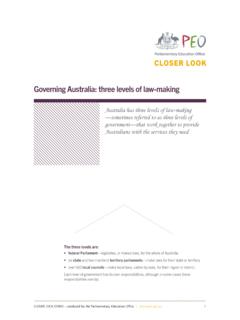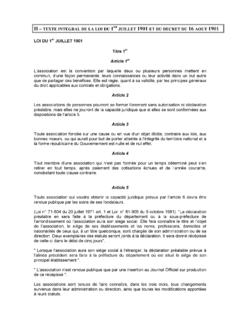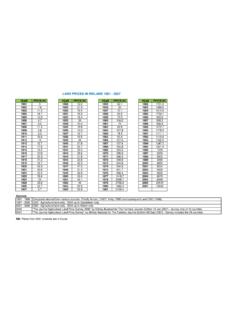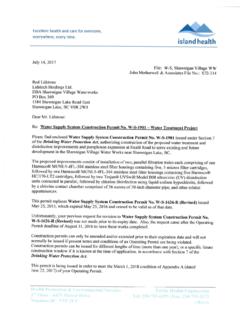Transcription of Closer Look: Federation - PEO
1 Closer LOOK SERIES produced by the Parliamentary Education Office | 1 Closer LOOKA sketch published in The Argus newspaper in 1898 urged the colonies to federateThe Argus, 1 June 1898, p5, National Library of Australia, NX11 FederationAustralia became a nation on 1 January 1901 when six British colonies New South Wales, Victoria, Queensland, South Australia, Western Australia and Tasmania united to form the Commonwealth of Australia. This process is known as s Federation came about through a process of deliberation, consultation and debate, unlike many other nations that unified as a result of war or conflict. Federation only went ahead with the approval of the people in a referendum (vote of the people).FEDERATIONCLOSER LOOK SERIES produced by the Parliamentary Education Office | 2 Reasons for federationBefore 1901 Australia did not exist as a nation.
2 It was a collection of six British colonies which were partly self-governing, but under the law-making power of the British Parliament. The colonies were almost like six separate countries; for example, each had its own government and laws, its own defence force, issued its own stamps and collected tariffs (taxes) on goods that crossed its borders. The colonies had even built railways using different gauges, which complicated the transport of goods across the the 1880s the inefficiency of this system, a growing unity among colonists and a belief that a national government was needed to deal with issues such as trade, defence and immigration saw popular support for Federation grow. Sir Robert Garran, who was active in the Federation movement, later reflected that the colonies were united by a combination of fear, national sentiment and self-interest.
3 The inconvenience of intercolonial travel. This illustration from Australasian Sketcher, 1887, shows travellers at Spencer Street Station in Melbourne standing by while their luggage is searched by customs officialsFree tradeWhile tariffs provided the colonial governments with much revenue, they restricted trade and movement between the colonies. Tariffs increased the cost of goods and made it hard for manufacturers based outside a colony to compete with local restrictions also inconvenienced travellers; the train journey between Melbourne and Sydney was delayed at the border in Albury while customs officials searched passengers luggage. Free traders were among the most vocal supporters of Federation , arguing that it would strengthen the economy by abolishing tariffs and creating a single Library of Australia, an23435998 Alfred Martin Ebsworth, State Library of Victoria, A/S04/10/87/15 SIR ROBERT RANDOLPH GARRANFEDERATIONCLOSER LOOK SERIES produced by the Parliamentary Education Office | 3 DefencePrior to Federation , the colonies were ill-equipped to defend themselves.
4 Each colony had its own militia consisting of a small permanent force and volunteers, but they all relied on the British navy to periodically patrol the vast Australian coastline. Increasingly, people feared the Australian colonies could be vulnerable to attack from nations such as Germany, France and Russia who had already colonised parts of the s position as a sparsely-populated continent close to Asia also gave rise to concerns that countries such as China and Japan, with their larger populations and greater military might, could overrun the colonies. Alfred Deakin, then Chief Secretary of Victoria, warned: The Asiatic wave which has threatened to engulf us is only suspended for a short time, but if the colonies do not federate our comparatively trifling white population will be swept before it like a feather.
5 The argument that a united defence force could better protect Australia was strengthened by a report released in 1889 by British Major-General Sir J. Bevan Edwards. It found that the colonies did not have enough soldiers, arms or even ammunition to adequately defend themselves. The report recommended a federal or centralised defence force be Australia is a multicultural nation; however, in the late 19th century many people wanted to maintain the British heritage of the some extent, this desire was prompted by concerns cheap non-white labour would compete with colonists for jobs, leading to lower wages and a reduced standard of living. These anxieties stemmed partly from anti-Chinese sentiment dating back to the gold-fields of the 1850s. They also reflected resentment towards Pacific Islanders who worked for low pay in Queensland s sugar sketch from the Illustrated Australian News, 2 July 1877, reflects contemporary fears the Australian colonies would be over-run by Asian immigration Outside, Sir!
6 Outside! , Punch, 2 June 1888. Some colonists wanted to maintain the British heritage of the coloniesPrior to Federation , the colonies were ill-equipped to defend themselvesIllustrated Australian News, National Library of Australia, an8870597 Linley Sambourne, in Punch, National Library of Australia, an8870609 FEDERATIONCLOSER LOOK SERIES produced by the Parliamentary Education Office | 4 Racial conflict was seen as an inevitable consequence of a multicultural society. It was felt a national government would be in a better position than the colonies to restrict and control prideColonists mostly shared a common language, culture and heritage, and increasingly began to identify as Australian rather than British. New South Wales Premier, Sir Henry Parkes, referred to this as the crimson thread of kinship that runs through us all.
7 In fact, by the time of Federation over three-quarters of the population were Australian-born. Many people moved between the colonies to find work and sporting teams had begun to represent Australia. In 1899 soldiers from the colonies who went to the Boer War in South Africa served together as Australians. The shift was apparent in contemporary songs and poems which celebrated Australia and our radiant Southern Cross We ll toil with hearts and hands; To make this Commonwealth of ours Renowned of all the landsFrom Advance Australia Fair by Peter Dodds McCormickAustralian troops, with a kangaroo mascot, onboard a ship bound for South Africa, Australian War Memorial, 129018 Australian troops, South Africa During the Boer War, soldiers from the six colonies served together as AustraliansAustralian War Memorial, sketch published in The Argus newspaper in 1898 urged the colonies to federateSporting union predated Federation .
8 In 1877 an intercolonial cricket team represented Australia in the first test match against England. In this cartoon the umpire tells the Australian cricket team: You ve done jolly well by combination in the cricket field, and now you re going to federate at home. Bravo, boys! Punch, National Museum of Australia. Photo Dragi MarkovicFEDERATIONCLOSER LOOK SERIES produced by the Parliamentary Education Office | 5A great national government for all Australians: the Federation ConventionsConvinced the colonies would be stronger if they united, Parkes gave a rousing address at Tenterfield in 1889 calling for a great national government for all Australians . Parkes call provided the momentum that led to Australia becoming a nation. Aware popular support was not enough, Parkes lobbied his fellow premiers to back 6 February 1890 delegates from each of the colonial parliaments and the New Zealand Parliament met at the Australasian Federation Conference in Melbourne.
9 The conference agreed the interests and prosperity of the Australian colonies would be served by an early union under the crown . It called for a national convention (formal meeting) to draft a constitution for the Commonwealth of Federation Convention: drafting a constitutionThe first National Australasian Convention was held in Sydney in March and April 1891, and was attended by delegates from each of the colonies and the New Zealand Parliament. During the convention, Edmund Barton, who was to become Australia s first Prime Minister, made famous the catchcry a nation for a continent and a continent for a nation .The convention spent five weeks discussing and then composing a draft constitution, which became the basis for the constitution we have today. While Queensland Premier, Sir Samuel Griffith, is largely credited with drafting the constitution approved by the convention, it was based on a version circulated by Tasmanian delegate Andrew Inglis Clark.
10 Clark was inspired by the federal model adopted by the United States (US), which, like Australia, faced the challenge of bringing together self-governing colonies as a nation. a nation for a continent and a continent for a nation Edmund BartonEDMUND BARTONM embers of the Australasian Federation Conference, 1890 Back row: Andrew Inglis Clark, Captain William Russell (New Zealand), Sir Samuel Griffith, Sir Henry Parkes, Thomas Playford, Alfred Deakin, Bolton Stafford Bird, George Jenkins (Secretary to the Conference)Seated: William McMillan, Sir John Hall (New Zealand), John Macrossan, Duncan Gillies, Dr John Cockburn, Sir James Lee SteereDPS AUSPICN ational Library of Australia, an14292110 FEDERATIONCLOSER LOOK SERIES produced by the Parliamentary Education Office | 6 CONSTITUTIONDRAFT 1 The phrase Washminster has been used to describe our system of government, as it blends features of the British Parliament and US federal modelUnder the draft constitution the colonies would unite as separate states within the Commonwealth, with power shared between a federal Parliament and state parliaments.












